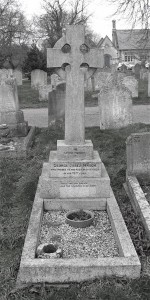
The Millers
Three local families owned and worked Stevens’ Mill from 1820 to 1955: the Carters, the Masons and the Stevens. By Steve Crane
Oliver Carter
The first owner, Oliver Carter, is shown as a miller of Burwell (and sometime beer retailer) in various trade directories between 1830 and 1869. Local doctor Charles Lucas remembered him as “… a stout old miller who wore a white hat, and brought grist to the mill in a yellow cart with red shafts and wheels.” In the 1841 census, Oliver Carter is recorded as a 42-year old Yeoman living in North Street, Burwell, with his wife Sarah and children Elizabeth (11), Oliver (9), James (7) and Sarah (3). They were all born in Burwell apart from Sarah, who was an incomer from Soham.
In 1851, someone broke into the mill and stole 30 stones of fine flour, a loss serious enough to be reported in the newspapers. By the time of the 1861 census, Oliver was listed as a miller employing one man, and had moved to High Town. In October 1862, the mill was struck by a ‘hurricane’ that blew off the cap and sails. The damage was estimated at £150 to £200. The mill was repaired and Oliver was still milling in 1871 at the age of 72, but died in late April of that year shortly after the census was taken.
George and Walter Mason

The Mason family of North Street, Burwell, were well-to-do farmers in the middle of the 19th century. In 1871 Henry Mason farmed 176 acres and employed six men and a boy. Two of his sons, Walter and George, were to become millers (an older son, William, would probably expect to inherit the farm).
Walter was born in late 1854 and after serving an apprenticeship (maybe with Oliver Carter?) was working in Burwell as a miller in 1881, living on the Causeway with his wife and young son. However by 1891 he had moved away from the countryside and was employed as a ‘Miller Foreman’ and living in West Ham, at that time a rapidly expanding borough on the outskirts of London. By 1891 he still had the same occupation but had moved even further away to Bromley, South London.
George was born in the village in 1858, and by the time of the 1881 census was already a miller and farmer of 19 acres employing two men. He then lived on North Street with his mother who had been widowed when her husband Henry hanged himself in 1873 – one of a rash of suicides in the village that year. George continued to run his businesses until at least 1916, marrying Mary Gibson from Manchester in 1888: they had two daughters, Gladys and Margaret. The family obviously prospered because by 1911 they were living in Pembroke Farm. George died in 1937 at the age of 78, and is buried in St Mary’s churchyard within sight of his mill (see right). He left nearly £3,000, a not inconsiderable sum.
Alfred and John Warren Stevens
In 1871 George Stevens was one of the numerous ‘fossil diggers’ in Burwell and other Cambridgeshire villages: in other words they extracted so-called coprolites, phosphate nodules which could be ground up to form high-quality fertiliser. By 1891 he had bettered himself and was now a farmer supporting a wife and seven children, all born in Burwell. The eldest child was Alfred, born in late 1871, and the only other son was John Warren (sometimes known just as Warren), born in October 1884.
Alfred worked as a miller’s assistant then began to operate his own mill, some time before 1901. Warren (pictured above at our mill) was working on the family farm at this stage. Farming and milling often seem to be closely related occupations, and in 1911 Alfred was running the family farm following his father’s death, with Warren listed as a horse keeper. It is believed that the brothers took over the mill which now bears their name sometime in the 1920s. Milling continued there until 1955 when Warren retired: he died in 1976 and is buried in Burwell parish cemetery. Alfred died in 1964 and is also buried there, in the same plot as their sister (Mary) Elizabeth Stevens.
